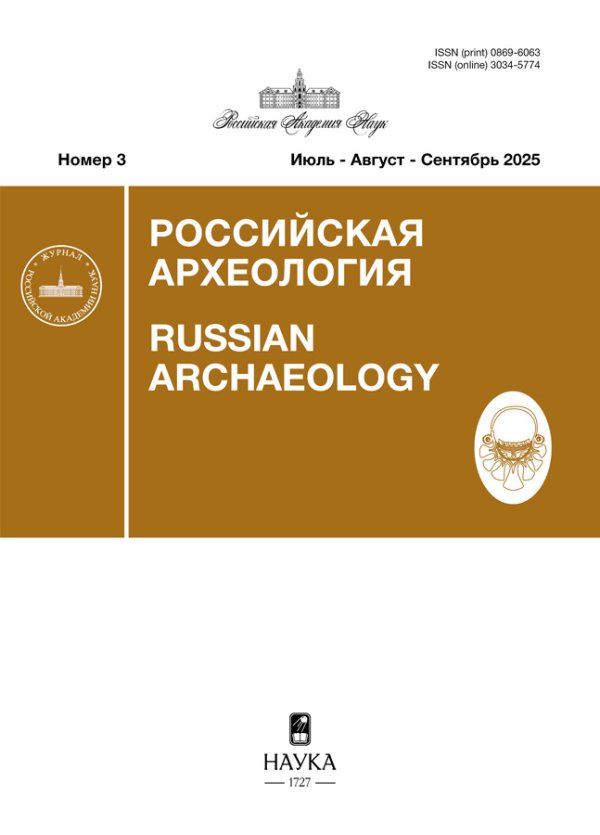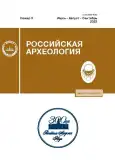STRATIGRAPHY OF THE CULTURAL LAYER OF THE MOSCOW KREMLIN: NEW DATA FROM THE 2019–2021 EXCAVATIONS
- Authors: Koval V.Y.1, Modin R.N.1, Makarov N.A.1
-
Affiliations:
- Institute of Archaeology RAS
- Issue: No 3 (2023)
- Pages: 98-113
- Section: ARTICLES
- URL: https://journals.rcsi.science/0869-6063/article/view/138915
- DOI: https://doi.org/10.31857/S0869606323030133
- EDN: https://elibrary.ru/PVPBPA
- ID: 138915
Cite item
Full Text
Abstract
In 2019–2021, the Institute of Archaeology RAS conducted excavations in the Great Garden of the Moscow Kremlin, east of the Archangel Cathedral, where the buildings of Prikazes (central administrative bodies of the Russian state) were located in the 16th–17th centuries AD. In the deposits, whose total thickness reached 6 m, it was possible to identify several layers, a part of which contained debris from the construction of the buildings of the Old (1591) and New (1675–1682) Prikazes. The foundations of the administrative buildings cut through earlier deposits of the second half of the 12th–16th century AD, among which a fire layer of the late 15th century stands out. It contains the remains of powerful fires, which destroyed the wooden structures of the estate that probably belonged to the descendants of Prince Vladimir Andreyevich the Bold. Another notable layer is that of the 14th century saturated with various imported artefacts; it is possible to relate it to a part of the area that was occupied by the court of Vladimir Andreyevich himself.
Keywords
About the authors
Vladimir Yu. Koval
Institute of Archaeology RAS
Author for correspondence.
Email: kovaloka@mail.ru
Russia, Moscow
Roman N. Modin
Institute of Archaeology RAS
Author for correspondence.
Email: modin.roman@mail.ru
Russia, Moscow
Nikolay A. Makarov
Institute of Archaeology RAS
Author for correspondence.
Email: nmakarov10@yandex.ru
Russia, Moscow
References
- Belyaev L.A., Glazunova O.N., Smirnov A.N., 2020. Tiles of the late 16th –first half of the 17th century based on materials from 2019 excavations in the Moscow Kremlin. Rossiyskaya arkheologiya [Russian archaeology], 3, pp. 114–124. (In Russ.)
- Boldin I.V., 2017. Moscow white-clay ceramics. Details for the picture. Tver’, Tverskaya zemlya i sopredel’nye territorii v epokhu srednevekov’ya [Tver, the Tver Land and adjacent territories in the Middle Ages], 10. Tver’: Institut arkheologii Rossiyskoy akademii nauk: Tverskoy nauchno-issledovatel’skiy istoriko-arkheologicheskiy i restavratsionnyy tsentr, pp. 170–176. (In Russ.)
- Dukhovnye i dogovornye gramoty velikikh i udel’nykh knyazey XIV–XVI vv. [Spiritual and contractual letters of the great and appanage princes of the 14th–16th centuries AD]. Moscow: Izdatel’stvo Akademii nauk SSSR, 1950. 585 p. Gakel’ E.V., Dzvonkovskiy S.L., Koval’ V.Yu., 2021. The ceramic assemblage dating to the last quarter of the 17th – early 18th century from the excavations of the New Prikazy building in the Moscow Kremlin. Kratkie soobshcheniya Instituta arkheologii [Brief Communications of the Institute of Archaeology], 265, pp. 222–229. (In Russ.)
- Koval V.Yu., 2001. White-clay ceramics in medieval Moscow. Rossiyskaya arkheologiya [Russian archaeology], 1, pp. 98–109. (In Russ.)
- Koval V.Yu., 2016. Pervichnaya fiksatsiya massovogo keramicheskogo materiala na pamyatnikakh epokhi Srednevekov’ya i rannego zheleznogo veka lesnoy zony Vostochnoy Evropy [Primary recording of frequent ceramic finds on the sites of the Middle Ages and the Early Iron Age in the forest zone of Eastern Europe]. Moscow: Institut arkheologii Rossiyskoy akademii nauk. 126 p. (Metodika polevykh arkheologicheskikh issledovaniy, 9).
- Koval V.Yu., 2019. Moscow black burnished ware. Arkheologiya Podmoskov’ya: materialy nauchnogo seminara [Archaeology of Moscow region: Proceedings of a scientific seminar], 15. Moscow: Institut arkheologii Rossiyskoy akademii nauk, pp. 383–400. (In Russ.)
- Koval V.Yu., 2022. Trade equipment from the bazaar area. Tsentral’nyy bazar Bolgara i ego okruzhenie (mezhdistsiplinarnye issledovaniya po materialam raskopok 2011–2019 gg.) [The central bazaar of Bolgar and its surroundings (interdisciplinary research based on excavations in 2011–2019)]. Moscow: Nestor-Istoriya, pp. 50–65. (Materialy i issledovaniya po arkheologii Bolgarskogo istoriko-arkhitekturnogo kompleksa, IV). (In Russ.)
- Krenke N.A., 2010. Artefacts of the Bronze and Early Iron Ages on the territory of Borovitsky Hill and its vicinity. Pamyatniki material’noy kul’tury IV tys. do n.e. – pervoy poloviny I tys. n.e.: katalog sobraniya Gosudarstvennogo istoriko-kul’turnogo muzeya-zapovednika “Moskovskiy Kreml’” [Monuments of material culture of the 4th millennium BC – the first half of the 1st millennium AD: Catalogue of the collection of the State Historical and Cultural Museum-Reserve “Moscow Kremlin”]. Moscow: Golden-Bi, pp. 47–55. (In Russ.)
- Kuzina I.N., Kurmanovskiy V.S., Solov’ev D.S., Elkina I.I., 2020. Events of 1812 in the Moscow Kremlin according to archaeological evidence. Triumf Pobedy v zerkale iskusstva: sbornik nauchnykh statey XXVI Tsarskosel’skoy konferentsii [Triumph of Victory in the mirror of art: Collected papers of the XXVI Tsarskoye Selo conference]. St. Petersburg: Russkaya kollektsiya, pp. 362–375. (In Russ.)
- Lopatina O.A., Koval V.Yu., 2022. New data on the Borovitsky hill in the Moscow Kremlin in the Iron Age (pottery evidence). Rossiyskaya arkheologiya [Russian archaeology], 3, pp. 152–167. (In Russ.)
- Makarov N.A., Koval V.Yu., Yaganov A.V., Modin R.N., Panchenko K.I., 2020. New research in the Moscow Kremlin: excavations of the Prikazy building. Rossiyskaya arkheologiya [Russian archaeology], 3, pp. 96–113. (In Russ.)
- Modin R.N., Koval V.Yu., Makarov N.A., 2023. Structures of the estate layout of the 14th – first half of the 16th century at excavation site I in the Great Kremlin Garden (based on the activities of the IA RAS in 2019–2021). Rossiyskaya arkheologiya [Russian archaeology]. (In Russ.) (In print).
- Osipov D.O., Koval V.Yu., Smirnov A.N., 2022. Shoe forgings from excavations in the Moscow Kremlin. Kratkie soobshcheniya Instituta arkheologii [Brief Communications of the Institute of Archaeology], 268, pp. 256–272. (In Russ.)
- Polnoe sobranie russkikh letopisey [Complete collection of Russian chronicles], 8. Prodolzhenie letopisi po Voskresenskomu spisku [Continuation of the Annals on the Resurrection list]. St. Petersburg: Tipografiya E. Pratsa, 1859. 301 p.
- Polnoe sobranie russkikh letopisey [Complete collection of Russian chronicles], 13, 2. Dopolneniya k Nikonovskoy letopisi. Tak nazyvaemaya Tsarstvennaya kniga [Additions to the Nikon Chronicle. The so-called Royal Book]. St. Petersburg: Tipografiya I.N. Skorokhodova, 1906. 303–532 p.
- Polnoe sobranie russkikh letopisey [Complete collection of Russian chronicles], 34. Postnikovskiy, Piskarevskiy, Moskovskiy i Bel’skiy letopistsy [Postnikovsky, Piskarevsky, Moscovian and Belsk chroniclers]. Moscow: Nauka, 1978. 304 p.
- Rabinovich M.G., 1971. The cultural layer of the central districts of Moscow. Materialy i issledovaniya po arkheologii Moskvy [Materials and research on the archaeology of Moscow], IV. Moscow: Nauka, pp. 9–116. (Materialy i issledovaniya po arkheologii SSSR, 167). (In Russ.)
- Romanova E.A., 2009. Glazed pottery of the 14th–16th centuries AD from excavations in Tver. Novgorod i Novgorodskaya zemlya. Istoriya i arkheologiya [Novgorod and the Novgorod land. History and archaeology], 23. Velikiy Novgorod: Novgorodskiy muzey-zapovednik, pp. 310–339. (In Russ.)
- Smirnov A.N., Koval V.Yu., Glazunova O.N., Panchenko K.I., 2020. Red-clay stove tiles from the excavations in the Great Garden of the Moscow Kremlin. Kratkie soobshcheniya Instituta arkheologii [Brief Communications of the Institute of Archaeology], 261, pp. 269–281. (In Russ.)
- Vdovichenko M.V., 2022. Sources on the development of the Prikaz embankment architectural look in the 17th century. Kratkie soobshcheniya Instituta arkheologii [Brief Communications of the Institute of Archaeology], 267, pp. 419–436. (In Russ.)
Supplementary files

















